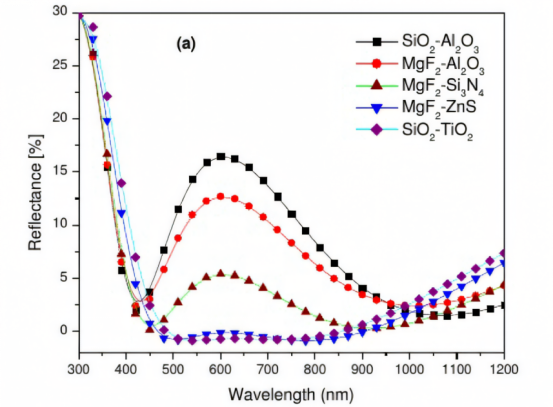
量子效率测试仪
PL/EL一体机
Sinton硅片少子寿命测试仪
Sinton硅块少子寿命测试仪
绒面反射率测试仪
3D共聚焦显微镜
清洗制绒工作站
在线四探针方阻测试仪
全自动扫描四探针方阻测试仪
在线薄膜厚度测试仪
晶化率测试仪
Horiba显微共焦拉曼光谱仪
傅里叶红外光谱仪
霍尔效应测试仪
分光光度计
全光谱椭偏仪
Horiba椭圆偏振光谱仪
TLM接触电阻率测试仪
超景深显微镜
网版智能影像测量仪
全自动影像测量仪
卧式拉力机
电池片稳态光衰老化试验箱
电池片紫外老化试验箱
电池片拉脱力综合测试仪
外观检验台
湿漏电测试系统
组件实验室EL测试仪
紫外老化试验箱
稳态光衰老化试验箱
电流连续性监测系统
PID测试系统
旁路二极管测试系统
LeTID测试系统
反向电流过载系统
脉冲电压测试系统
绝缘耐压测试仪
接地连续性测试仪
绝缘耐压接地测试仪
湿热环境试验箱
湿冻环境试验箱
热循环试验箱
动态机械载荷测试机
静态机械载荷测试机
冰雹冲击试验机
引出端强度试验机
霰弹冲击试验机
抗划伤(切割)测试机
剥离试验机
万能材料试验机(单臂)
万能材料试验机(双臂)
光伏玻璃透过率测试仪
醋酸测试试验箱
交联度测试系统
二极管接线盒综合测试仪
落球冲击试验机
半自动四探针
全自动探针式台阶仪
多通道太阳能MPPT系统
Horiba稳瞬态荧光光谱仪
钙钛矿P1激光划线测试仪
钙钛矿在线膜厚测试仪
钙钛矿工艺检测工作站
手持式IV测试仪
便携式EL测试仪
手持热成像测试仪
户外组件IV测试仪
户外组件多通道测试系统
光伏逆变器电能质量测试仪
无人机EL检测仪
抗反射涂层对太阳能电池性能的影响
日期:2024-09-04浏览量:5
光伏发电是一种将太阳能转化为电能的效应。无抗反射涂层的太阳能电池表面的反射率非常高,超过30%的入射光会从硅表面反射,因此太阳能电池性能面临的主要挑战是反射损耗。光捕获、表面纹理和抗反射涂层等是减少反射损耗最广泛使用的方法。美能绒面反射仪是太阳能电池片生产厂商检测反射率的利器,可以测试电池片对不同波长段的光的反射率强度。采用衍射光栅光谱仪,通过光栅进行色散,分辨率更高。

抗反射涂层理论
抗反射涂层(Anti-Reflection Coating, ARC)在太阳能电池中起着至关重要的作用,其主要目的是减少光在表面的反射,从而增加光的透射率,提高光电转换效率。大部分太阳能电池都涂有抗反射涂层,一套优化设计良好的前表面抗反射涂层,可以将电池前表面的反射率从30%降低到5%以下。

两种介质界面处的反射
上图展示了“薄膜中的光干涉”原理(是基于光波在不同介质界面之间反射和透射时发生的干涉现象)。从界面a和b反射的光进行破坏性干涉,从而将其能量传递给电池。当入射光正常照射在覆盖有厚度为d1透明层的硅表面时,反射能量的表达式为:

对于零反射率的透明层:

单层抗反射涂层
不同材料的单层抗反射涂层(SLARC)及其折射率如下表所示。

不同材料的单层抗反射涂层及其折射率
为了提高太阳能电池的性能,要考虑到太阳光谱的分布和硅相对的光谱响应,选择合理的波长。太阳光谱中的能量峰值出现在0.5μm处,而太阳能电池的相对光谱响应峰值在0.8-0.9μm波长范围内,因此抗反射效果最好的波长范围在0.5-0.7μm。

无涂层和涂有单层抗反射层的硅的反射率随波长的变化
从图中可以看出,无抗反射涂层的硅电池反射率很高(30%),在波长大于 500nm时,涂有SLARC的硅反射率<20%,在波长 600nm时,涂有Al2O3和 Si3N4的硅反射率<0.4%。反射率仅在一个波长处最小,而其他波长处较高。在高波长侧逐渐增加,在低波长侧急剧降低。硅太阳能电池有抗反射涂层有助于显著降低反射率。
双层抗反射涂层
通过双层抗反射涂层(DLARC)进一步降低反射率。对于双层抗反射涂层,反射率的表达式更为复杂,表示为:


具有DLARC的硅太阳能电池反射率随波长的变化
上图显示了反射率随波长的变化,DLARC的反射率曲线呈W形,意味着反射率在对应两个波长时达到最小值,能够在宽波长范围(400 - 1200nm)内降低反射率。从图中可以清楚地看出,DLARC的效果要比SLARC好得多。在450 - 900nm波长范围内,MgF₂/ZnS和 SiO₂/TiO₂的DLARC反射率几乎可忽略不计。
抗反射涂层对太阳能电池性能的影响
对带有抗反射涂层的太阳能电池性能进行评估,包括短路电流(Isc)、开路电压(Voe)、填充因子(FF)和效率(η)等参数,如下表所示:

AM 1.5照射下SLARC和DLARC硅太阳能电池的光伏数据
由表可以看出,无抗反射涂层的硅太阳能电池效率为9.3%,而Si3N4的单层抗反射涂层,太阳能电池效率为13.6%,对于 MgF₂/ZnS和SiO₂/TiO₂的双层抗反射涂层,太阳能电池的效率分别达到了14.28%和14.34%。

内部量子效率随光波长的变化
对于双层抗反射涂层中的 MgF2/ZnS和SiO2/TiO2,在450-900nm的波长范围内,内部量子效率>95%,其中短路电流增加了约52%。内部量子效率的提高对应着短路电流的增加,这表明 DLARC有助于提高太阳能电池对光子的利用效率,从而提升电池的性能。
由此可见,SLARC 可部分改善太阳能电池性能,而设计合理的 DLARC 可在很大程度上改善性能,通过应用SiO2/TiO2的DLARC可实现低反射率,短路电流从2.18增加到3.32,光伏效率约为14.34%。
美能绒面反射仪

联系电话:400 008 6690
美能绒面反射仪RTIS通过漫反射激发电池片,然后通过8度角采用光谱仪检测。RTIS具有定位的机台和导轨,能够方便而快速地送入样品,实现电池片样品的定位,提高使用人员的工作效率。
■ 光谱测试范围可达350-1050nm
■ <span style="font-famil




































































